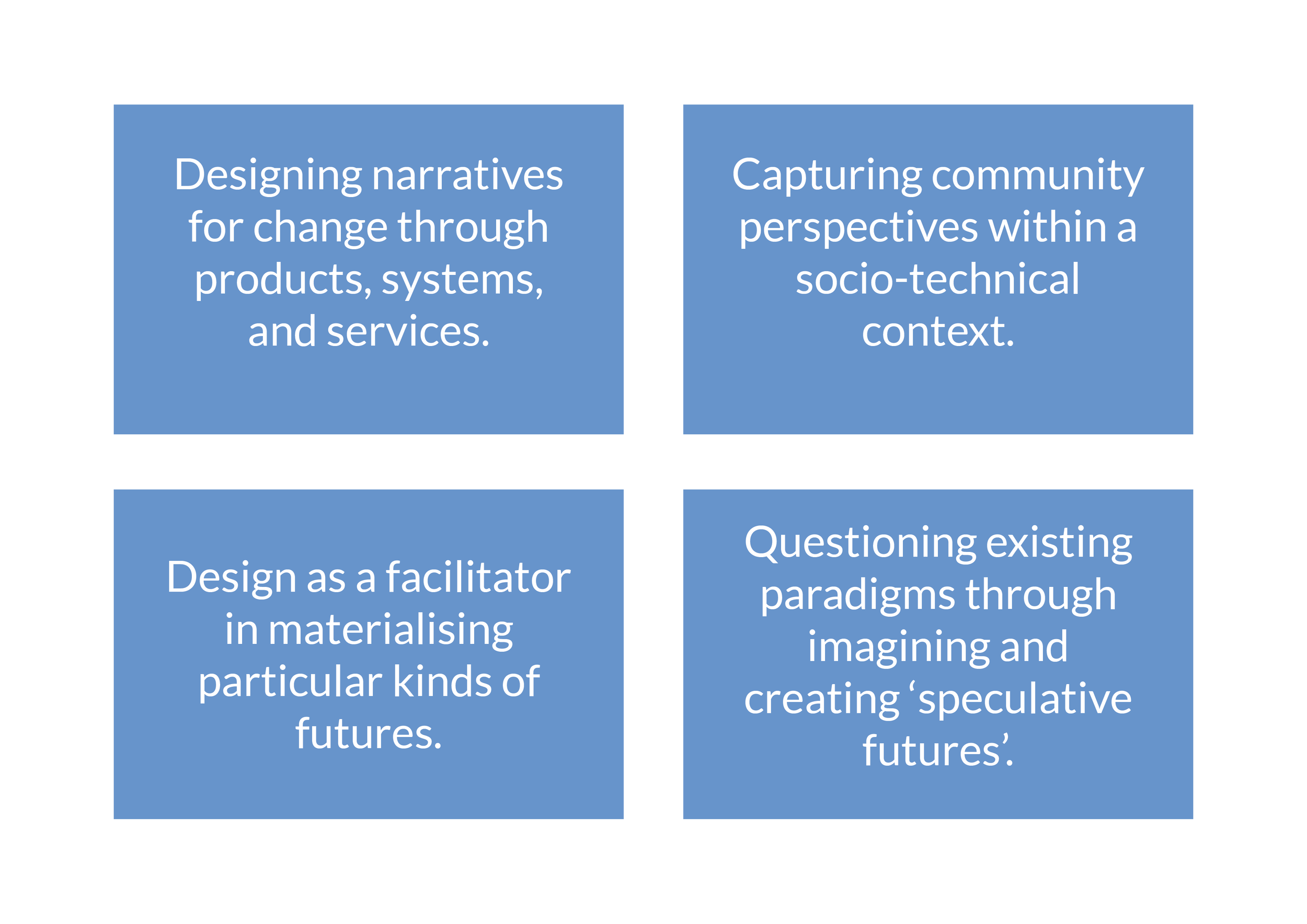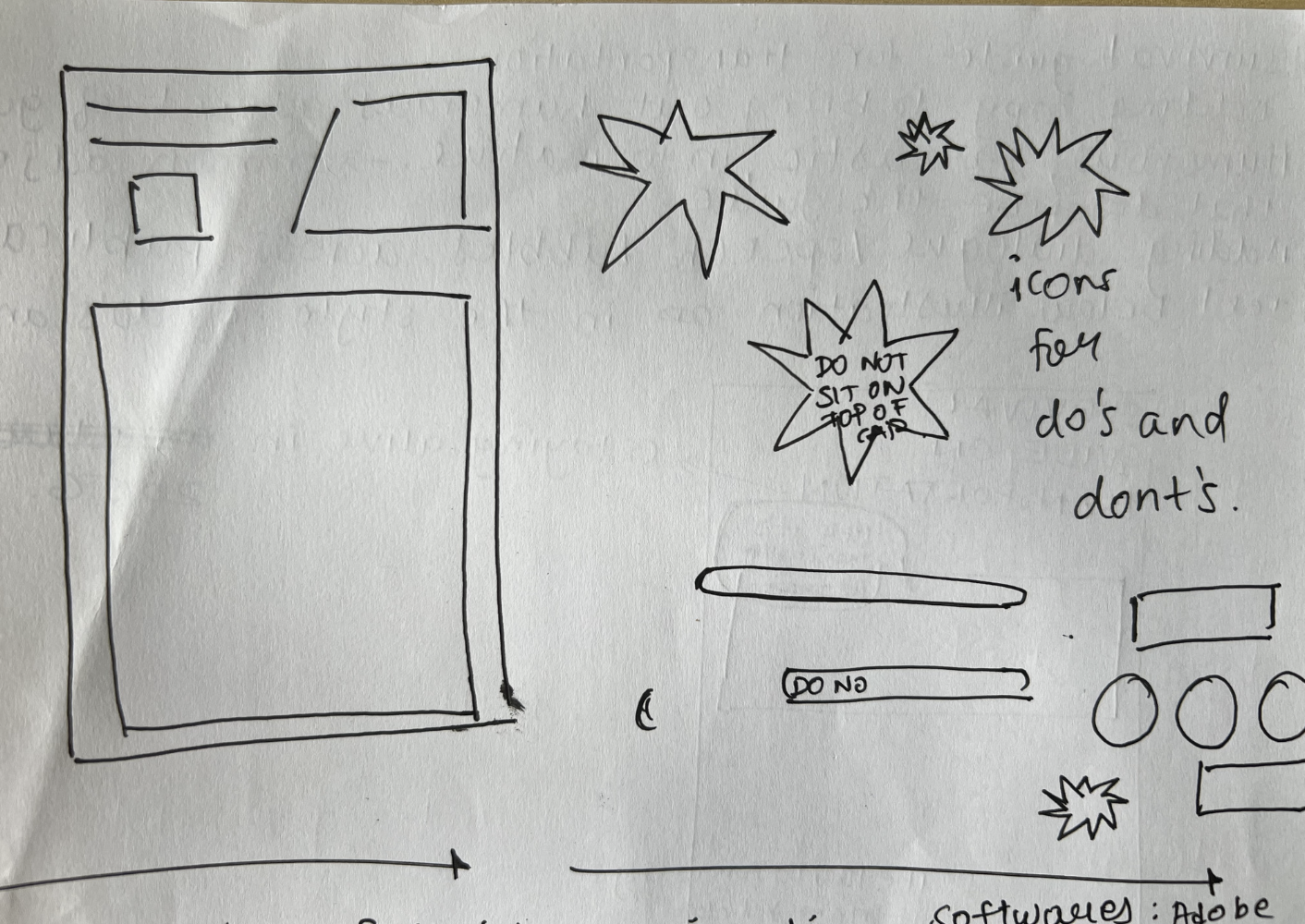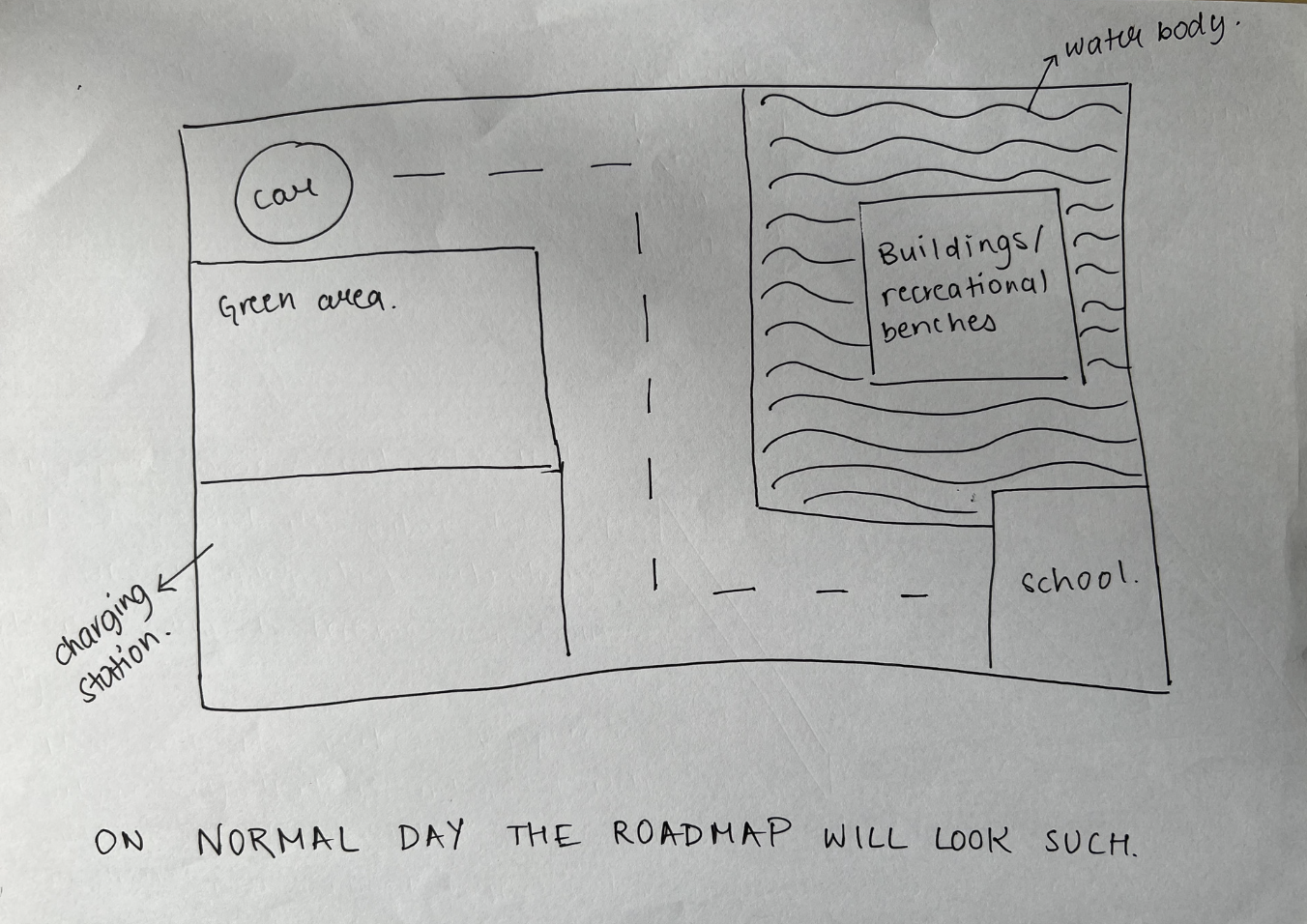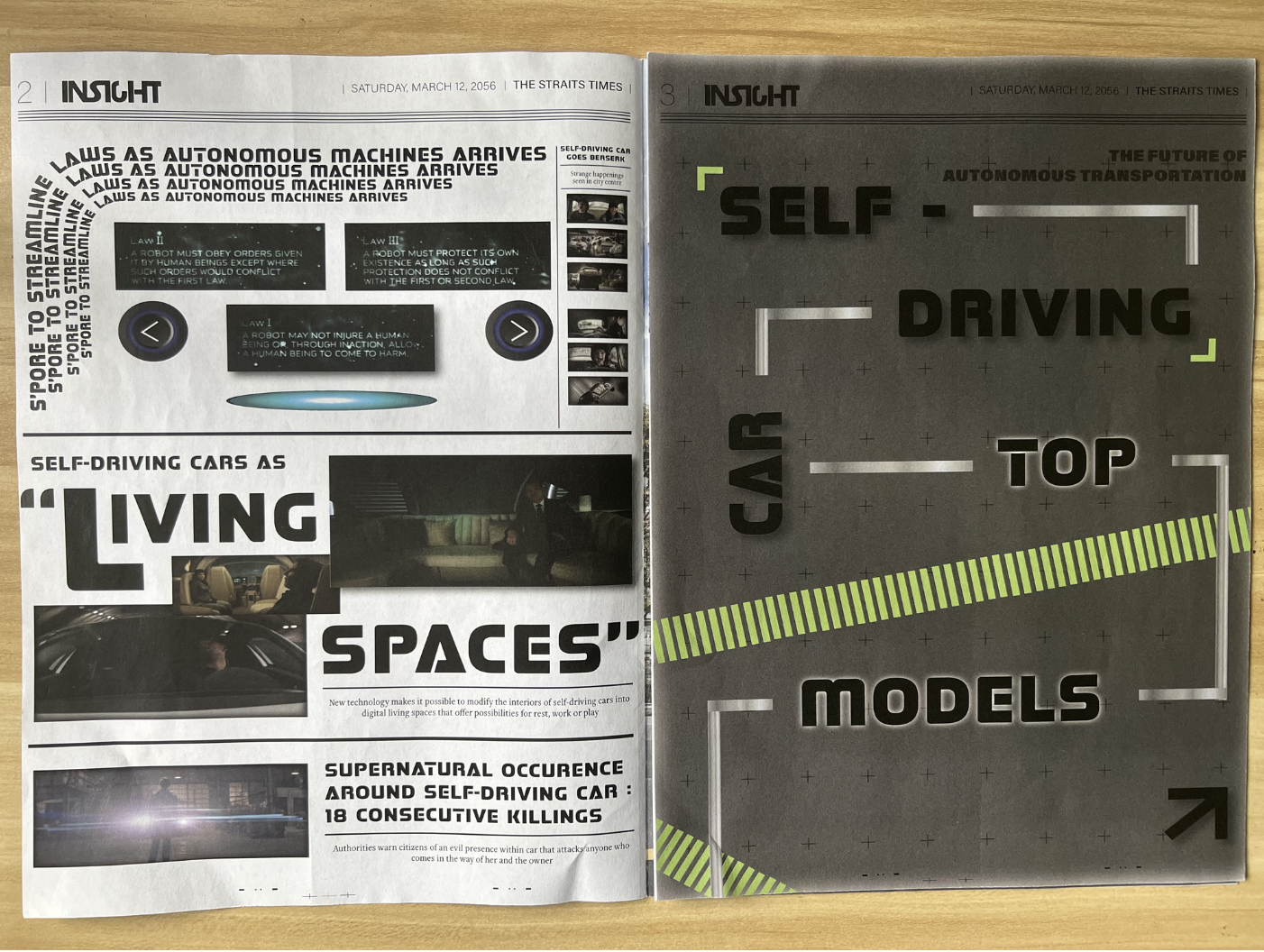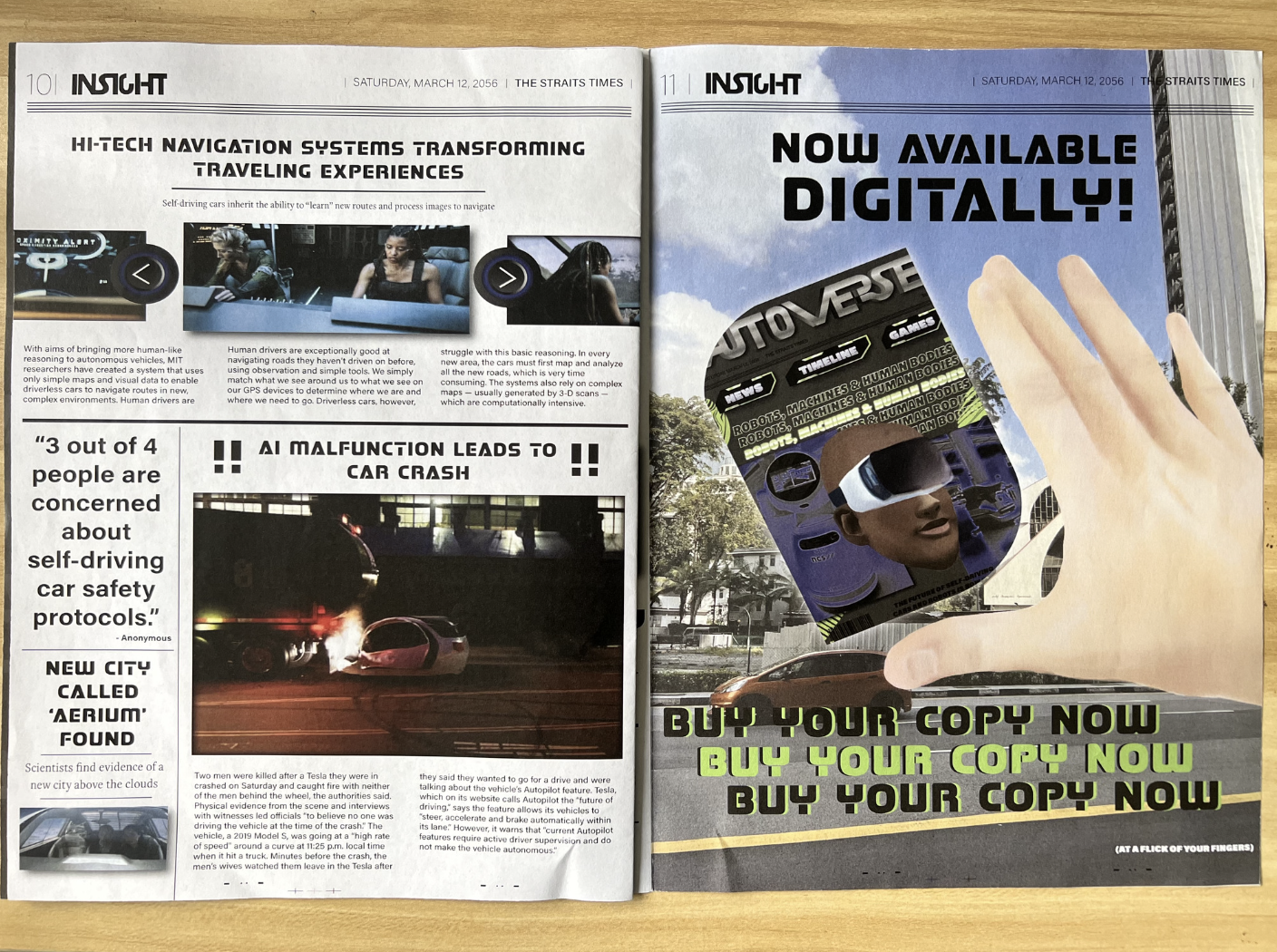The following project was completed over 9 months and involved extensive research, prototyping, and testing to come down to a solution that aligns best with the project’s area of research - The Era of Self - Driving Vehicles and Speculative Design Fictions for the Future.

Challenge :
The future of the integration surrounding Autonomous Vehicles (AV’s) within Smart Cities like Singapore is fast approaching. However, the unpredictability of what it would look like for humans to function within it, leads to a feeling of anxiety and uncertainty. Owing to the importance of a well integrated ecosystem comprising AV’s, human beings, and self-driving urban landscapes, there exists a need to re-contextualise the relationship between humans and machines for the future. Therefore, within the context of communication and human-machine interaction, in what ways can the gaps present between socio-technical imaginaries and AV’s be bridged through design for the future ?
Solution :
A speculative project that focusses on the human-machine interaction and relationship within self-driving urban landscapes through the lens of investigating future possibilities for autonomous transportation systems in hi-tech, smart cities.
RESEARCH
Upon finalising a brief for the project, I attempted to deconstruct it by establishing research goals in order to create possible narratives.
RESEARCH METHODOLOGIES
Through six different research methodologies, I was able to collect data on each facet of the brief and answer the research goals.
INTERVIEWS
I conducted in-depth qualitative interviews with professionals within the service and user experience industry from frog Design regarding the key aspects of the research objective.
“ I used to use smart devices like a toy and now it’s become a part of my life.”
—— Participant
Insight : Through the interviews it became apparent that majority of people including daily commuters and car enthusiasts are keen to see the future integrations between self-driving vehicles and humans. However, a primary concern still remains to be the ethical considerations surrounding the use of these machines in our daily lives. Therefore, I scaled up the research process by further investigating the relationship between humans and autonomous machines.
VISUAL ANTHROPOLOGY
I used visual anthropology as a method to capture visuals representing humans and autonomous machines within a socio-technical context. I did this through a critical analysis of sci-fi films and photography to delve deeper into understanding the scientific and cultural imaginations of humans and vehicles within the self-driving landscape.
Image from the sci-fi film I, Robot (2004)
Autonomous robots in action, images taken in Singapore
Insight : After visiting places where autonomous robots have been implemented and in action while performing different roles, it can be inferred that the impact that integration of AI has on our lives is gradually being felt and seen in Singapore. This further hints to the biggest transformation in AI and autonomous machines rising in Singapore that has much to do with self-driving cars and its impact on human - machine relationship.
SKETCHING PROBE
I set up a drawing or sketching brief for ages between 5 - 25 years. This helped in building research on the project brief as participants visually expressed their ideas through sketch. Moreover, the “experience of flow” as the participant is fully immersed in the creative activity provides insights into ways in which human beings think of and visualise self-driving cars of the future.
“I imagine the future cars as light weight cars which have the capability to fly… wings like airplanes for balance… like traveling in space cars… different shaped cars - like fun shapes for example fish or hot air balloons… emits gas at a faster speed.”
Insight : The sketches add onto the future possibilities of integrating autonomous vehicles into hi-tech, urban landscapes, while also considering all demographics and personality types between the ages of 5-25 years to draw their interpretations freely.
OBSERVATIONAL RESEARCH
I conducted an observational research study of the “Connected and Autonomous Vehicle Summit” which is a conference that was held on 23rd September 2021 in India. The session was conducted on an online platform with industry experts in the field of autonomous vehicles as panel members and helped in building on my findings through two important insights - autonomous vehicles and its integration into modern and urban landscapes and human-machine interaction which helps embrace different ideas as we venture into the area of self-driving vehicles from the perspective of a fantasy into reality through creation of ideas, designs, and prototypes.
Insights : Technological interventions into autonomous vehicles are the biggest enablers of humankind and is currently in the midst of experimentations and convergence of different technologies.
BRAINSTORMING SESSION
i conducted a brainstorming session comprising six questions at frog Design wherein 20 participants i.e., designers and interns from various roles in UI/UX design, shared their insights and ideas around user-centric designs for HMI in the context of self-driving cars.
How might we integrate a digital cockpit in an autonomous car ?
How do you think cars should interact with pedestrians ?
How might we humanise intelligent cars that run on AI ?
How might the user journey begin once a passenger steps inside the car ?
Insights : By conducting a brainstorm workshop I was able to gather insights into how, why, and what human beings envision the future of self-driving vehicles to be. This involved gathering viewpoints related to human traits associated with self-driving cars, the aspect of connectivity, and safety protocols within such landscapes.
Insights :
PERSONA
I learnt through my research that future technological innovations in the transportation sector will primarily impact the daily commuters and the ways in which they use the various modes of transportation when vehicles become autonomous. By developing persona types, I was able to further identify pain points with a hypothetical scenario.
SPECULATIVE MODEL FRAMEWORK
I developed an interconnected chart to help create an authentic inter-connection between my deliverables. By creating an ecosystem map each deliverable will have its own scenario, story, task, action items, and end result all tied up to the persona and therefore connect and converge all deliverables.
IDEATION
AR Tabloid : In order to be as generative as possible, I ideated features that could bring out the digital side of the print media through bringing together augmented reality and art.
AR filter on top of the cover page that enhances the experience of entering the world of humans and self-driving cars through print media.
Survival Guide : The survival guide will take a speculative approach towards envisioning the plethora of possibilities that autonomous vehicles provide humans with in a future city. In doing so, the guide comprises autonomous vehicles created by big tech firms in reality and sets them in context of HMI in a future city.
Future city prototype : Creating a model city and a video animation to visualise and explain the relationship between a self-driving car and human in an urban landscape using the three scenarios below.
DESIGN, TEST, ITERATE
After numerous presentations, feedback sessions, and exhibits, I iterated and modified specific aspects and features of the prototypes to ensure the products are usable and well-received. Some sessions helped in evaluating proof of concept as users were given a walk through of the three prototypes.
PROTOTYPE 1 : SURVIVAL GUIDE ON TRANSPORTATION FOR FUTURE CITY
PROTOTYPE 2 : FUTURE CITY MODEL PROTOTYPE
PROTOTYPE 3 : AR TABLOID AND ENVELOPE DESIGN












